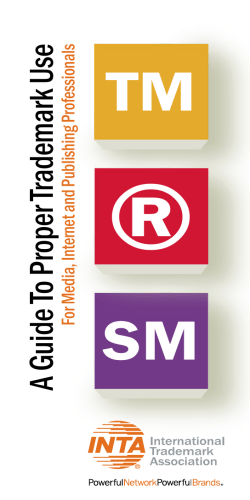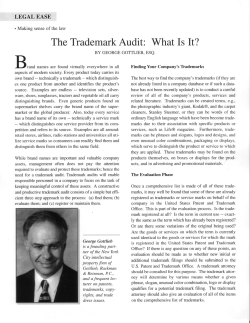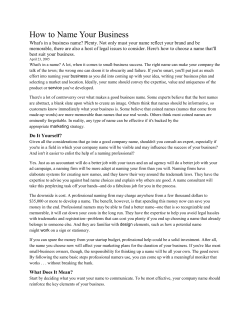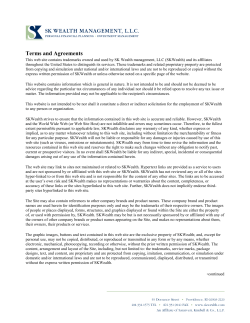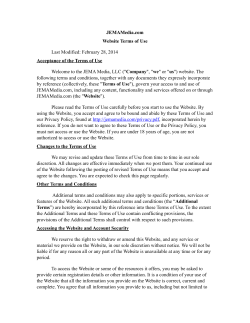
Should the Pattern Be the “Brand”?: A Potential Revenue- Generating Bonanza
Guest Article Should the Pattern Be the “Brand”?: A Potential RevenueGenerating Bonanza Marc A. Lieberstein, Esq. – Kilpatrick Townsend & Stockton LLP – [email protected] Kristin G. Garris – Kilpatrick Townsend & Stockton LLP – [email protected] Patterns are all the rage – on clothing, footwear, interior and in some cases the pattern owner, is not aware that the pattern exterior design, textiles, and more. Designers have even serves the legally defined role of a trademark; i.e., identifying the associated entire lines or seasons with particular patterns and source of the products. had great success. So, can a pattern, by itself, become the brand? And if so, are LILLY PULITZER Pattern See www.lillypulitzer.com there revenue-generating opportunities for pattern owners that emanate from the bridge between trademark and copyright rights that can protect the pattern simultaneously? The answer to both questions, as discussed in this article, is yes. And while the bridge has not always been utilized fully to create a brand identity in a pattern, if properly used, this bridge could not only deliver a strong brand to the marketplace, but also supplement protection for the pattern/brand by giving pattern owners additional enforcement tools, as well as opening doors to a broader array of revenue streams by way of licensing, product-line expansion, or other ventures. MISSONI Pattern See www.missoni.com Patterns as Brands (Trademarks). Nearly every consumer can think of a pattern that is identified solely with one brand owner – the plaid lining of a BURBERRY coat, the monogram or checkerboard pattern on LOUIS VUITTON bags, the stylized GG pattern on GUCCI handbags, and even the varied and colorful patterns of LILLY PULITZER-branded or MISSONI-branded apparel – all comprise distinctive patterns that immediately act as source-identifiers.1 Put another way, consumers consider certain patterns to be brands (trademarks), even if the consumer, and 1 1 For an example of how patterns or prints are used to enhance branding, see the web page at <http://blog.lillypulitzer.com/2012/11/05/a-print-worth-celebrating-in-thebeginning/>, where LILLY PULITZER prints can be downloaded “as a background for your mobile device, iPad, computer, and Facebook cover photo.” See also the “Shop Prints” page at <http://www.lillypulitzer.com/section/Shop-Prints/9.uts>. ©2013 The U.S. Patent & Trademark The maturity of patterns to now serve as brands results in new Office database ways for their owners to increase revenue. Instead of just licensing shows that many patterns are in word marks and logos, pattern owners can license the pattern fact registered as trademarks. separately, and expand into areas of the marketplace where Louis Malletier the word marks or logos might not be able to go; e.g., a foreign (“USPTO”) Vuitton owns country where the word mark or logo is not protectable or carries U.S. Trademark Reg. No. 1653663 a derogatory or unsavory connotation when translated. Such for its classic pattern shown here: patterns are also endowed not only with protection as a trademark Corporation (“LVM”) More recently, LVM U.S. Trademark secured Reg. No. 3576404 for a different pattern that LVM describes as a “mark [that] consists of squares with a checkered pattern of light and dark with the unusual contrast of weft and warp . . . The pattern appears over substantially the under federal and state law3, but also usually have an added layer of copyright protection under federal law and in most foreign countries, provided the patterns satisfy certain requirements.4 This dual-protection scheme, and the enforcement measures it provides, should empower the pattern owner to more effectively thwart infringers and counterfeiters. Protecting Patterns as Brands (Trademark and Copyright) n n n entire surface of the goods.” Trademark and copyright rights have different origins and Burberry’s classic plaid pattern pattern and prevent copying. to the under No. right is purposes, but can work together or separately to protect the registered U.S. Trademark 3529814, among Reg. others, and is described as follows: “… The mark consists of a tan background, light tan vertical and horizontal lines, black vertical and 1. Trademark Protection The purpose of a trademark is to identify the particular source of goods or services. A trademark can be a word, symbol, design, or even color (TIFFANY blue, for example).5 In the United States, trademark rights are created by use of the mark, not registration. horizontal lines, white squares, Patterns that are not registered, but which serve as trademarks, and red vertical and horizontal lines, forming a plaid pattern. The may be protected under federal law, which prohibits false mark also consists of a repeating check design applied in whole or representations, false descriptions, and false designations of in part on or in connection with the goods or services. The mark is origin in the sale of goods and services. They are also protected not limited to position or placement.” under common law in all states, and most states have laws The aforementioned pattern owners clearly see that their patterns serve as trademarks, not just fabric designs. And these pattern owners represent the current trend where governing deceptive trade practices, fair business practices, or false advertising statutes that prohibit unfair competition, including trademark infringement. designers are increasingly using their patterns to build new A pattern owner with a registered trademark may sue for federal brands, attract new customers, and expand their branded statutory trademark infringement, unfair competition, and dilution product lines. Pattern owners appear to no longer rely solely in some cases, and has equitable and monetary remedies available on their word marks or logos to distinguish their products. when the owner’s trademark rights are infringed, including seizure, New patterns may be used each season to set a designer or recall orders, and injunctive relief and/or damages (statutory seasonal collection apart from others. Christina Brinkley said damages for counterfeiting, actual damages, profits, and/or fees it well in her 2012 Wall Street Journal article titled “A Pattern and costs, as applicable).6 Emerges”: “This season, Prada’s rumbling car prints represent the label loudly and clearly . . . More subtle and creative than a logo, prints are a way for designers to brand their creations without slapping initials on them.”2 Christina Brinkley, Wall Street Journal, “A Pattern Emerges” (Feb. 25, 2012). In addition to building common law trademark rights through use over time, a trademark owner can build trade dress rights over time as well. See Vaughn Mfg. Co. v. Brikam Int’l Co., 814 F.2d 346, 348 n.2 (7th Cir. 1987) (“A product’s trade dress is the overall image used to present it to purchasers; it could thus include, to give a partial list, the product’s size, shape, color, graphics, packaging, and label.”). 4 Another form of protection for patterns may be provided by a design patent (as opposed to utility patents), although this form of pattern protection is beyond the scope of this article. A design patent protects the ornamental characteristics (the appearance) of an object, not its functional features. See 35 U.S.C. § 171. In 2012, Lululemon Athletica Canada Inc. sued Calvin Klein and G-III Apparel Group, Ltd., claiming that certain of the defendants’ running tights and waistband pants infringed two design patents owned by Lululemon for the design elements found in the plaintiff’s pant style and waistband design. See Case No. 1:12-cv-01034-SLR (D. Del. 2012). See generally http://www.uspto.gov/patents/resources/types/designapp.jsp for additional information on design patents. 5 U.S. Trademark Reg. No. 2416795. 6 See 15 U.S.C. §§ 1114 et seq. 2 3 ©2013 2 Trademark infringement under federal and state law is found when For fashion designers, for example, the particular style or design a person or entity uses a mark or imitation of a mark that is likely of a dress or jacket may not be copyrightable12, but the pattern to cause consumer confusion, to cause mistake, or to deceive used on the dress or jacket, or even the hang tag or label, may consumers.7 Determining whether a likelihood of confusion exists very well be.13 Copyright owners must show that their designs requires considering a number of factors.8 A mark owner is not are “nonfunctional.” However, even the design of a useful article required to prove that all, or even a majority, of these factors favor is eligible for copyright protection if that design “incorporates a likelihood of confusion.9 pictorial, graphic, or sculptural features that can be identified There are other significant benefits to trademark registration for patterns. For example, having a registered trademark and taking advantage of customs recordal procedures for such registered separately from, and are capable of existing independently of, the utilitarian aspects of the article.”14 Think of the plaid on BURBERRY clothing or the LOUIS VUITTON patterns shown above. patterns in the U.S. (and other jurisdictions such as Canada, China, Unlike trademarks, copyright rights do not depend on use.15 or the European Union) can help a brand owner keep counterfeit Copyright rights are established when a work is created in a fixed and gray market goods out of the U.S. Owners of U.S. trademark tangible medium of expression16 − although in order to sue for registrations may record these with U.S. Customs and Border copyright infringement under U.S. federal law you must 1) have a Protection, an agency under the auspices of the Department of copyright registration (some jurisdictions in the U.S. allow you to Homeland Security, to assist that group in its efforts to prevent sue if you have an application in process), and 2) register the design importation of goods that infringe registered marks. within three months of its first publication or the infringement.17 2. Copyright Protection Copyright rights can even extend outside the U.S., as many 10 11 A copyright protects the expression of an idea − original works of authorship fixed in a tangible medium. Copyrights are generally not available for words, symbols, slogans, common designs, or monograms, but a copyright does protect the elements of a work that are original. Copyright protection is available for a work that contains sufficient originality and expressive elements. A pattern, for example, can be protected by copyright if it is 1) independently created, and 2) possesses a spark or minimal degree of creativity, even if parts of the pattern (circles, squares, etc.) existed previously. Copyrights can give pattern owners protection for things that may not otherwise have protection under trademark or patent law. countries recognize and offer protection to foreign copyrights under certain conditions through treaties and conventions such as the Berne Convention.18 For trademarks, there is no worldwide treaty under which you can enforce your rights; separate enforcement efforts are necessary in each country. Additionally, a copyright can cover instances where the copied pattern appears on any goods, regardless of whether they compete with the pattern owner’s products or if they are listed in the trademark registration. Finally, the copyright application process is inexpensive and usually noncontentious, unlike the USPTO trademark registration process. Copyright rights can in some cases be easier to enforce than trademark rights.19 Like trademark registrations recorded in the Id. at § 1114(1). See factors set forth in In re E.I. du Pont de Nemours & Co., 476 F.2d 1357, 1361 (C.C.P.A. 1973): (1) similarity or dissimilarity of the marks in their entireties as to appearance, sound, connotation, and commercial impression (2) similarity or dissimilarity and nature of the goods or services as described in an application or registration or in connection with which a prior mark is in use (3) similarity or dissimilarity of established, likely-to-continue trade channels (4) conditions under which and buyers to whom sales are made, i.e. “impulse” vs. careful, sophisticated purchasing (5) fame of the prior mark (sales, advertising, length of use) (6) number and nature of similar marks in use on similar goods (7) nature and extent of any actual confusion (8) length of time during and conditions under which there has been concurrent use without evidence of actual confusion (9) variety of goods on which a mark is or is not used (house mark, “family” mark, product mark) (10) market interface between applicant and the owner of a prior mark…. (11) The extent to which applicant has a right to exclude others from use of its mark on its goods (12) extent of potential confusion, i.e., whether de minimis or substantial (13) any other established fact probative of the effect of use. 9 See id. at 1362; In re Mighty Leaf Tea, 601 F.3d 1342, 1346 (Fed. Cir. 2010) (“Not all of the DuPont factors are relevant to every case, and only factors of significance to the particular mark need be considered.”). 10 Gray market goods are goods that are legitimately sold abroad under a particular mark and then imported into the U.S. and sold in competition with goods offered by the trademark owner. They typically are genuine goods not intended for sale or distribution in the U.S., which are then sold at a price below that of the authorized U.S. goods bearing the identical trademark. Some products are constructed or formulated in different ways to suit national conditions, standards, tastes, or laws/regulations. 11 See <https://apps.cbp.gov/e-recordations/> and 19 C.F.R. § 133.0 et seq. See also Section 526 of the Tariff Act (19 U.S.C. § 1526) and Section 42 of the Lanham Act (15 U.S.C. § 1124). 12 See, e.g., Eve of Milady v. Impression Bridal, Inc., 957 F. Supp. 484 (S.D.N.Y. 1997) (citing Knitwaves, Inc. v. Lollytogs Ltd. (Inc.), 71 F.3d 996, 1002 (2d Cir. 1995)). 13 Id. (“fabric designs ‘are considered “writings” for purposes of copyright law and are accordingly protectible’” and “plaintiffs’ lace designs are copyrightable” (quoting Knitwaves Inc., 71 F.3d at 1002)). 14 Id. 15 While trademarks require maintenance and use, trademark rights are unlimited in terms of the time period for which an owner can have protection. However, copyright protection (for works created after Jan. 1, 1978) has time limits: 70 years after author’s death, or, if it is a work made for hire, 95 years from year of first publication or 120 years from year of creation, whichever comes first. 16 Copyright protection (for works created after January 1, 1978) vests as soon as the copyrightable work is fixed in a tangible medium. 17 If the registration was not within this three-month window, recovery is limited to actual damages and non-duplicative profits of the infringer. But, if the copyright application is filed within five years of the first publication of the work, the registration certificate will be prima facie evidence of the validity of the copyright and of the facts stated in the certificate. 18 See Berne Convention for the Protection of Literary and Artistic Works, Sept. 9, 1886, 828 U.N.T.S. 221, S. TREATY DOC. No. 99-27 (1989) (codified in various sections of 17 U.S.C. § 106A (2006)). There is no “worldwide copyright,” and international recognition and enforcement is generally contingent on laws of the country in which recognition is sought. 19 See Lisa Pearson, Andrew Pequignot, and Ashford Tucker, “US copyright protection for logos, packaging, and products,” Intellectual Property, 37 (Oct. 2010); 1 J. THOMAS MCCARTHY, MCCARTHY ON TRADEMARKS AND UNFAIR COMPETITION § 6:14 (4th ed. 2010) (“MCCARTHY”). 7 8 3 ©2013 USPTO, copyright registrations may be recorded in the U.S. Revenue Opportunities n n n Copyright Office. Unlike trademark infringement cases, which may require survey evidence or testimony from experts, copyright A pattern that serves as a protectable brand and, separately, a infringement may be less expensive to prove. For copyright protectable copyright is likely to be in a position to provide its infringement, you must show: 1) ownership of a valid copyright, owner with multiple forms of revenue. and 2) copying of copyrightable, protected elements of the work − or, when evidence of direct copying is lacking, you must prove (a) access to the copyrighted work, plus (b) substantial similarity. The 20 trademark infringement test, however, requires finding a likelihood of confusion after evaluating several factors, including those concerning consumers and marketplaces or distribution channels. Supra note 8. The substantial similarity test for copyrights does not require an evaluation of the marketplace or consumer perspective. Also, an infringer violates an exclusive copyright at the moment the infringer copies (or adapts, distributes, performs, or displays) the work. 21 Under trademark law, mere reproduction alone does not necessarily constitute infringement; an infringer violates trademark law only when the infringer causes a likelihood of confusion, or dilution, or unfairly competes; i.e., when the infringer jeopardizes a trademark owner’s goodwill in a mark by use of a confusingly similar mark or dilution of a famous mark.22 The U.S. Copyright Act provides remedies such as awards of statutory damages and attorneys’ fees for works that are timely registered23, so a copyright owner would not have to prove actual damages or show that the infringement was “exceptional,” as a plaintiff would for a trademark infringement case, in order to get attorneys’ fees. Copyright enforcement tools can therefore be useful in addition to those used to protect patterns that also may serve as trademarks. And copyright rights can even cover certain patterns or other designs while a brand owner is simultaneously developing trademark rights in such patterns. One cautionary note for pattern owners: it is important to secure your rights if a non-employee or independent designer creates your pattern. If an independent contractor was used, you will need − ideally prior to creation of any pattern − a work-for-hire agreement signed by the contractor.24 Otherwise, if the work is created before you have such an agreement, you should secure an assignment of the contractor’s rights. With respect to assignments, the independent contractor, as the author, retains the right to terminate the assignment after 35 years.25 Also note that you will want to have all rights in the pattern conveyed to you, including the right to sue and the right to create derivative works. Otherwise, the Brand licensing of a pattern can generate revenue beyond the owner’s particular use of the pattern to different geographic areas, demographics, products, services, and/or distribution channels. Such licensing generates considerable revenue for both brand owners (through royalty payments) as well as their licensees (who benefit from the use of the trademark in which the owner has built goodwill and reputation over many years). As noted above, sometimes the pattern can be used and protected in territories in which the word mark or logo may not extend. And the pattern can often be translated or morphed into use in connection with or on products never contemplated with respect to the word mark or logo. For example, the pattern owner could license use of the pattern for furniture, bedding, or other housewares, or even on the packaging, hang tags, or labels for such products. Licensing the copyright in a pattern can result in different revenuegenerating opportunities. A copyright license of the pattern to manufacturers in completely different industries could generate significant royalties. For example, a wallcovering designer could create a pattern for a wallcovering, but then license the copyright in the pattern to an upholstery or carpet manufacturer, or even for use in posters or other products like clothing or accessories. The cache and goodwill built in the pattern in the wallcovering arena could add significant value to these copyright licenses for the pattern owner and its licensees. Another benefit to building a pattern brand/copyright asset is that it could significantly increase the purchase price and value of the business associated therewith. And the pattern owner may more easily part with the pattern to be sold because the owner could always develop a different or new pattern. A licensor can earn revenue in various ways; e.g., a one-time flat fee to the licensor, or a use-based royalty which itself can be fixed or variable.26 Royalties are generally based on net sales: the licensee pays royalties on the actual sales revenue it receives. A licensor also generally requires a minimum guaranteed royalty payment by the licensee as an incentive to the licensee to generate sales.27 independent contractor may be able to exploit those rights even after the assignment. With respect to patterns for which there are copyright rights, a designer can even embed unique designs to make it easier to detect copying. When a designer or brand owner suspects copyright infringement, these unique embedded elements can help prove copying. This type of embedding can be used, by the way, in other ways by copyright owners. Unique codes can be embedded in written works so that persons or entities can search for and find unauthorized copies of the works on the Internet. 21 See 17 U.S.C. § 501; 2 MELVILLE B. NIMMER & DAVID NIMMER, NIMMER ON COPYRIGHT § 8.01 (Matthew Bender, rev. ed.) (“NIMMER”); MCCARTHY § 6:14. 22 5 MCCARTHY §§ 6:14, 23:1; 4 Louis Altman & Malla Pollack, CALLMANN ON UNFAIR COMPETITION, TRADEMARKS & MONOPOLIES § 22:17 (4th ed. 1997). 23 If the work is registered within 3 months of its publication, the copyright owner is entitled to seek statutory damages (in lieu of actual damages and profits that are otherwise available) and attorneys’ fees. 24 See id. (specific limitations on, and the definition of, a work-for-hire). 25 Id. at § 203. 26 When a license is royalty-free, this is usually stated explicitly in the license. 27 R.C. Henn Jr., A.G. Jones, L.S. Ralls, and L.A. Linder, “Trademark Licensing Basics,” Kilpatrick Stockton LLP Intellectual Property Desk Reference (6th ed.) (2009). 20 ©2013 4 In addition to the different types of royalties and rates, other key Conclusion n n n considerations in formulating a pattern license agreement include the following: nscope (exclusive or non-exclusive) nwhich products can use the pattern as a brand or as a copyright; nthe length (term) of the license, whether it can be renewed, and whether the licensee will have the right of first refusal or first negotiation ndistribution channels in which the licensed products can be sold and distributed (even listing specific retail stores or websites, or specifically denying permission to sell through the Internet or off-price stores) ncountries in which the products can be sold nquality assurances and controls, including standards for manufacturing and prohibitions on the use of child labor or slave labor (or even prohibitions on the manufacturing of licensed products in certain countries), and instructions on the approval process (the extent to which the licensor must approve the licensed products and specific uses of licensed mark(s)) nrequirements concerning how sales/revenue are reported to the licensor nindemnification provisions nenforcement particularities and how the license can be terminated28 In sum, pattern owners stand in the unique position of creating not only brands, but also at the same time valuable copyrightable works that, if strategically licensed or sold, could generate significant revenue from unexpected, new sources. And because the rights in a pattern may be subject to dual protection and enforcement, they stand to survive attempts to copy and dilute the strength of the pattern, thereby increasing the life and value of the pattern as a brand and a copyright. Marc A. Lieberstein, Esq. is a Partner with Kilpatrick Townsend & Stockton LLP. His practice focuses on intellectual property licensing in the consumer products, industrial design, and fashion industries; implementation of branding and commercialization objectives; and counseling clients on creating strategies for procuring, protecting, and enforcing their global intellectual property assets. Mr. Lieberstein can be reached at +1.212.775.8781 or [email protected]. Kristin G. Garris is an Associate in the New York office of Kilpatrick Townsend & Stockton LLP. Her practice focuses on trademark and copyright litigation and counseling, domain name and other Internet-related disputes, and trademark licensing. Ms. Garris can be reached at +1.212.775.8786 or [email protected]. This article is intended for general information purposes only and is not intended to provide, and should not be used in lieu of, professional advice. The publisher assumes no liability for readers’ use of the information herein and readers are encouraged to seek professional assistance with regard to specific matters. Any conclusions or opinions are based on the individual facts and circumstances of a particular matter and therefore may not apply in other matters. All opinions expressed in these articles are those of the authors and do not necessarily reflect the views of Stout Risius Ross, Inc. or Stout Risius Ross Advisors, LLC. As with any business venture, there can be drawbacks to license arrangements. So a pattern owner interested in licensing its patterns as a brand or a copyright must recognize the benefits and drawbacks and take them into consideration during the license negotiation.29 Drawbacks can include: the loss of complete control over the brand or design; the fact that only a percentage of the sales revenue is earned; the risk that a licensee will damage the reputation or image and hinder future growth; and the risk that the owner’s rights can be deemed abandoned if the owner does not appropriately monitor the licensee’s use and exercise sufficient quality control.30 Crafting license agreements to address these issues carefully is important in protecting the pattern, and ensuring a long and valuable revenue stream for years to come. For more information about trademark licensing, and details not covered in this article, see M. Lieberstein, S. Feingold, C. James, and P. Rosenblatt, “Current Developments and Best Practices in Trademark Licensing (Parts I and II),” The Licensing Journal (Part I, Vol. 31, No. 2, Feb. 2011; Part II, Vol. 31, No. 3, Mar. 2011). 29 Id. 30 R.C. Henn Jr., A.G. Jones, L.S. Ralls, and L.A. Linder, “Trademark Licensing Basics”: Depending on the particular industry and/or the products at issue, quality control provisions may address a number of issues to ensure adequate quality control and prevent abandonment, including, by way of example: (1) Being involved in the design process for the product; (2) Reviewing early models and prototypes; (3) Reviewing packaging, advertisements, labels, and other materials to ensure that the mark is used properly and appears in a manner consistent with the licensor’s trademark guidelines; and (4) Requiring access to the licensee’s facilities, raw material, finished products, personnel, and records to monitor the licensee’s adherence to the licensor’s quality standards. 28 5 ©2013
© Copyright 2026
